Li S.Z., Jain A.K. (eds.) Encyclopedia of Biometrics
Подождите немного. Документ загружается.

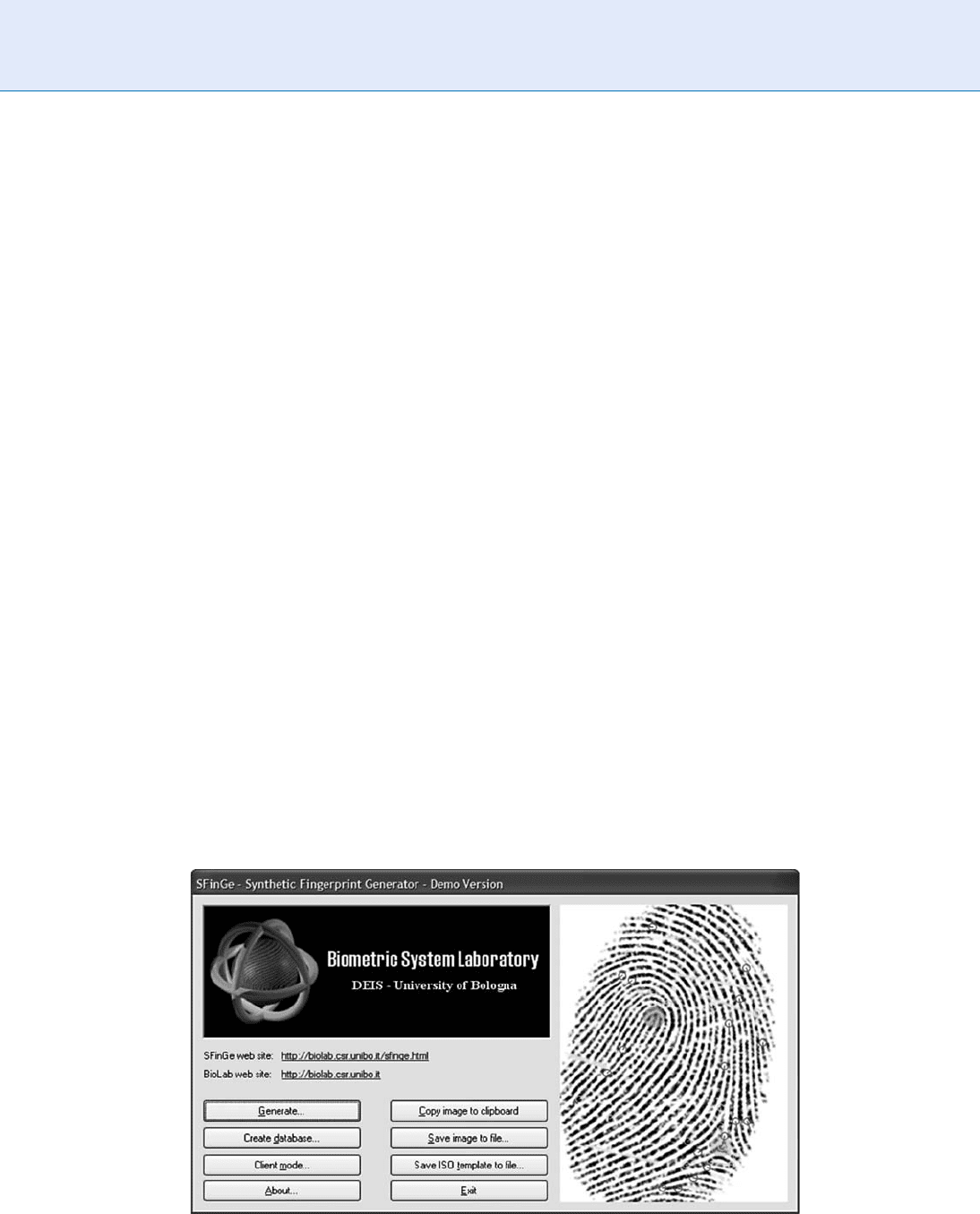
Definition
SFinGe (Synthetic Fingerprint Generator) is a finger-
print sample synthesis approach developed by the
Biometric System Laboratory of the University of
Bologna (Italy). It is available as a software program
able to generate large databases of images very similar
to human’s fingerprints, together with
▶ ground-truth
data about their characteristics and features. These
databases are particularly useful for developing, opti-
mizing and testing fingerprint recognition systems and
are being extensively used by industrial, academic and
government organizations.
Overview and History
SFinGe (the Italian for sphinx, pronunciation sphin-je)
is the acronym for Synthetic Fingerprint Generator.
SFinGe can be used to easily create large databases of
fingerprints, thus allowing recognition algorithms to
be simply trained, tested and optimized. The images
generated emulate fingerprints acquired with on-line
sensors (see
▶ Fingerprint Acquisition) but, with a few
changes, the simulation of impressions produced by
the ink-technique is also possible.
This
▶ fingerprint sample synthesis approach
was developed at the Biometric System Laboratory of
the University of Bologna (Italy) [1] since 1999; the
first version of the method [2] was able to synthesize
realistic fingerprint patterns, but limited to only one
impression of each ‘‘synthetic fing er’’. Appropriate
techniques for simulating more impressions of the
same finger were developed at the end of 2000 , suc-
cessfully adopted to generate one of the test databases
for the first Fingerprint Verification Competition [3],
and described, for the first time, in [4]. In 2002, realis-
tic background generation capabilities were added [5]
and, in 2004, an improved noise model was developed
[6]. More recently, the approach has been expanded
with the generation, for each synthetic fingerprint
image, of
▶ ground-truth minutiae information
(i.e., the precise location and characteristics of each
minutia) and other features (such as the
▶ orientation
field)[7].
A software tool for generating fingerprint images
according to the SFinGe method has been provided
by the Biometric System Laboratory of the University
of Bologna since 2001. A demo version of this tool
(Fig. 1) can be downloaded from http://biolab.csr.
unibo.it/sfinger.htm l and has been used to prepare
most of the figures in the following sections.
The Generation Process
Fig. 2 shows a functional schema of the generation
approach. SFinGe adopts a statistical ridge pattern
model (see fingerprint sample synthesis) to create
a master-fingerprint (that is the unique and immutable
SFinGe. Figure 1 The user interface of the SFinGe software tool.
1170
S
SFinGe

characteristics of a ‘‘synthetic finger’’) through the
following steps [5]:
1. Fingerprint shape generation: Definition of the global
shape of the fingerprint, according to a simple
model based on elliptical segments;
2. Orientation field generation: A mathematical ridge-
flow model allows to generate a consistent orienta-
tion field;
3. Frequency map generation: The local ridge-line fre-
quency is generated on the basis of some heuristic
criteria;
4. Ridge-line pattern generation: Ridge-lines and min-
utiae are created using space-variant filtering.
Once a master-fingerprint has been created, one ore
more of its ‘‘impressions’’ can be randomly generated,
by applying the following steps [5]:
5. Selection of the contact region: The ridge-line pat-
tern is translated without modifying the global
fingerprint shape and position (this simulates
different finger placements over the acquisition
device);
6. Variation of the ridge-line thickness: Morphological
operators are applied to simulated different degrees
of skin dampness and/or finger pressure;
7. Fingerprint distorti on: A skin disto rtion model is
adopted to simulate the effects of skin elasticity;
8. Noising and rendering: A gray-scale noisy image
is produced by modeling some of the factors that
deteriorate the quality of real fingerprints;
9. Global translation/rotation: The image is randomly
translated and/or rotated, to simulate real finger-
prints that usually are not perfectly centered and
can present a certain amount of rotation;
10. Background generation: A realistic background
can be created to simulate a given acquisition
device.
Fig. 2 shows, for each of the steps described above, the
various input parameters (graphically represented by
the red arrows). The SFinGe software tool lets the user
SFinGe. Figure 2 A functional schema of the SFinGe generation approach: each rounded-box represents a step (based
on a corresponding mathematical model); the main parameters are reported between square brackets. Steps 1–4
create a master-fingerprint, steps 5–10 generate the final synthetic image.
SFinGe
S
1171
S
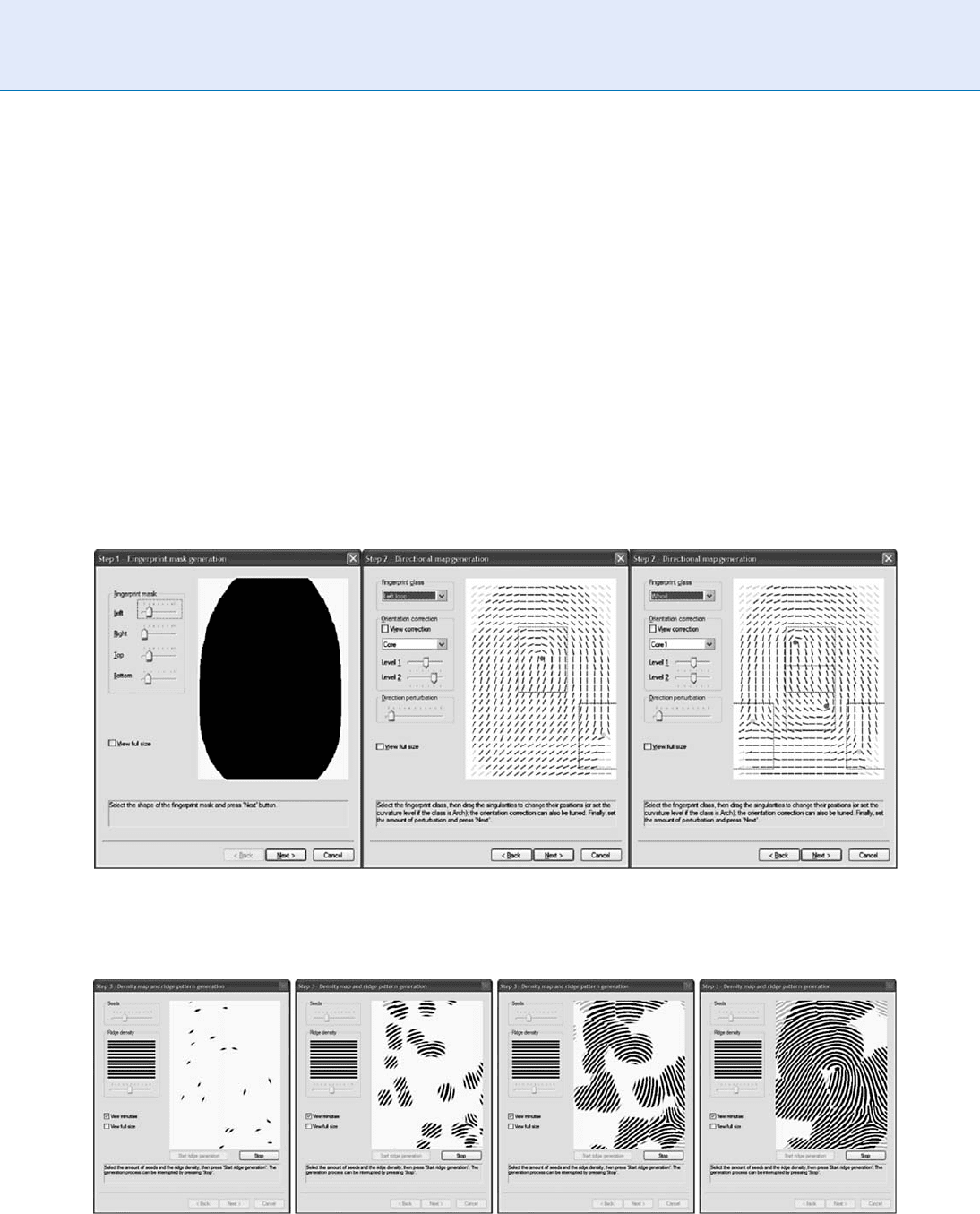
adjust most of those parameters and observe the
corresponding effects on the synthetic fingerprint (see
Figs. 3–7). The software also allows a database of syn-
thetic fingerprints to be batch-generated, given a relatively
small set of input parameters (see Fig. 8), including:
number of fingers, impressions per finger, image size,
seed for the random number generator, maximum
amount of noise, maximum amount of deformation.
During the batch-generation of a fingerprint database,
each master-finger is gen erated by using a different
seed for the random number generator; those seeds
are randomly selected as well. During the generation
of a single database, all the seeds chosen are different;
although it is reasonable to assume that different seeds
imply different fingerprints, it might happen that two
different seeds produce almost identical finge rprint
images. To reduce this hypothetical risk, SFinGe adopts
one of the best
▶ pseudo-random number generators
proposed in the scientific literature [8].
The creation of minutiae ground-truth proceeds
in parallel with the fingerprint generation (Fig. 9): the
standard minutiae extraction procedure defined in [9]
is applied to the master-fingerprint, then all the rele-
vant transformations executed on the fingerprint are
applied to the minutiae (e.g., translation, rotation,
distortion). This approach has some clear advantages:
1. The features can be extracted by applying the stan-
dard procedures easily and without ambiguities,
since the extraction occurs on a binary image with-
out any noise;
2. The ground truth is always unique and sound,
even when the quality of the final image is very
low (see Fig. 10).
SFinGe. Figure 3 Graphical user interface for the fingerprint shape generation (left) and orientation field generation
(middle and right).
SFinGe. Figure 4 Graphical user interface for the ridge-line pattern generation.
1172
S
SFinGe
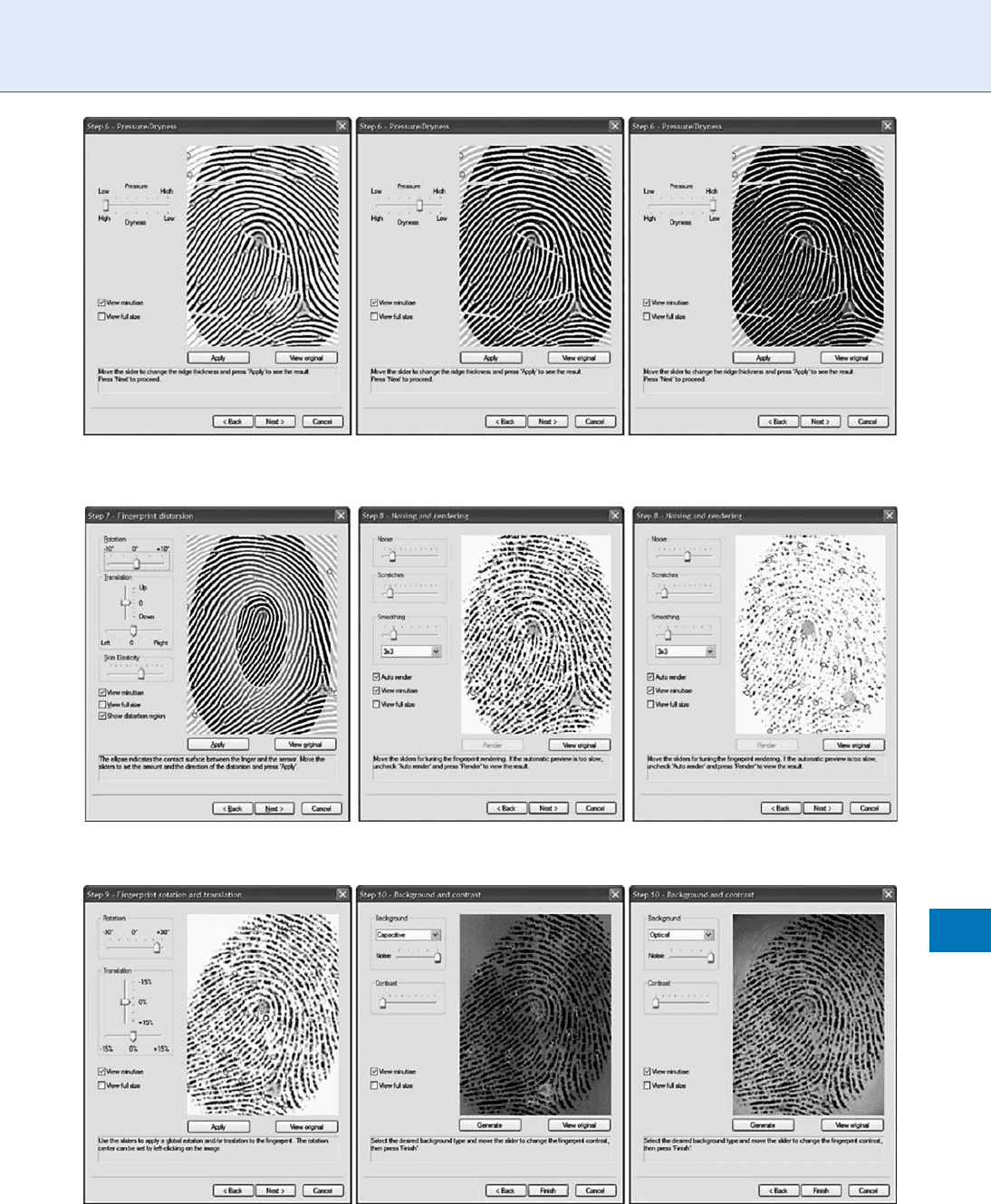
SFinGe. Figure 6 Graphical user interface for fingerprint distortion (left) and noising (middle and right).
SFinGe. Figure 5 Graphical user interface for the variation of the ridge-line thickness.
SFinGe. Figure 7 Graphical user interface for global rotation/translation (left) and background generation (middle
and right).
SFinGe
S
1173
S

Generation of other ground-truth features is per-
formed in a similar fashion; for instance, all the rele-
vant transformations can be applied to the orientation
field calculate d at step 2, thus obtaining the true orien-
tation field of the final synthetic fingerprint.
The automatic generation of a whole fingerprint
database (including ground-truth data) is totally
parallelizable, since the generation of each master-
fingerprint (with its impressions) is independent of
the others. This makes it possible to distribute the
SFinGe. Figure 8 The batch-generation options.
SFinGe. Figure 9 Generation of ground-truth minutiae data.
1174
S
SFinGe
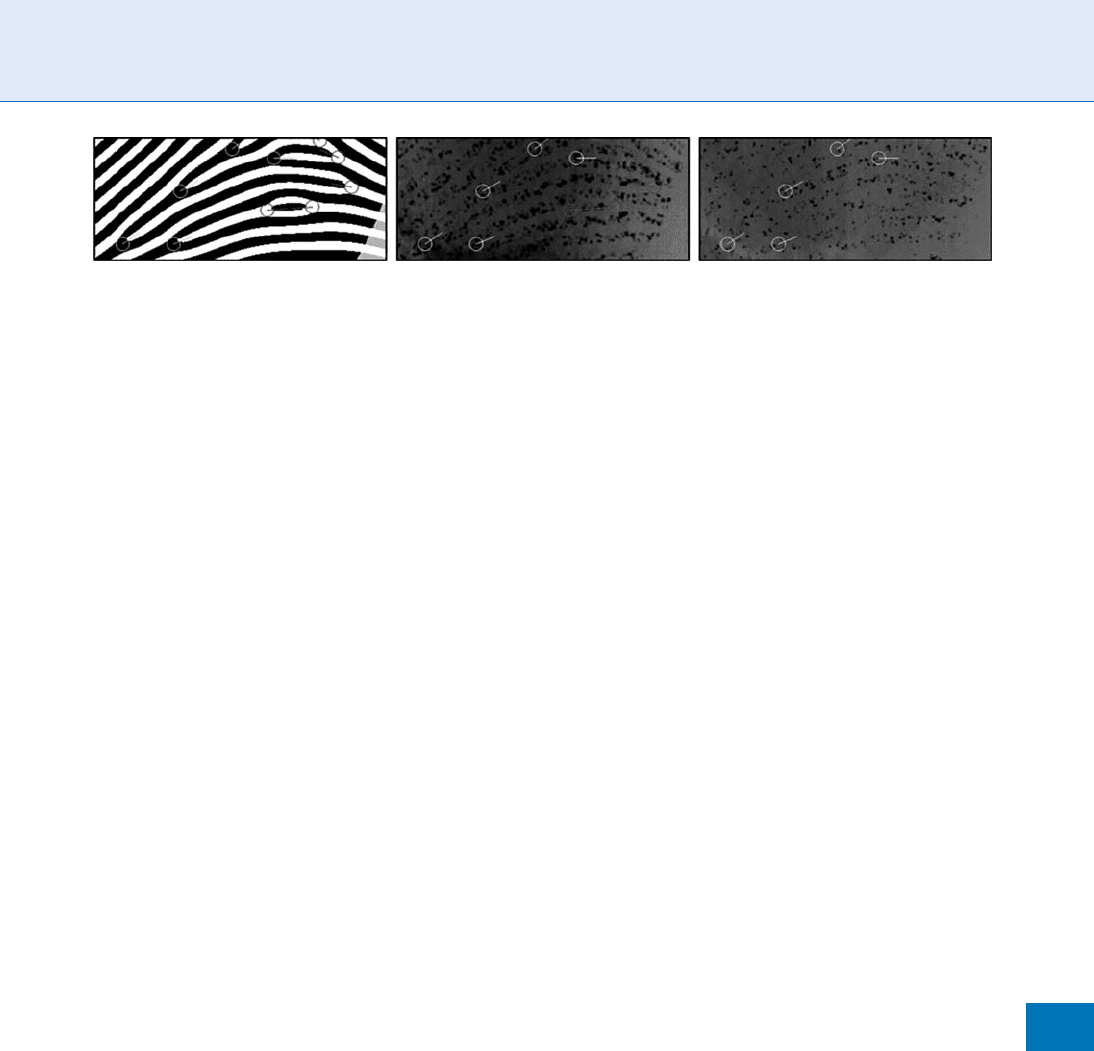
process on many computers; for instance, using ten
3GHz PCs in a network, a database of 100,000 finger-
prints (10,000 fingers, 10 impressions per finger) can
be generated in less than two hours.
Applications
SFinGe can be used to create, at zero cost at without
any
▶ privacy issue, large databases of fingerprints,
whose main characteristics can be controlled and
adjusted according to the specific needs of a given
application. Furthermore, ground-truth data about
the main fingerprint features can be automatically
produced for each fingerprint in the database. SFinGe
has been used by many industr ial, academic and gov-
ernment organizations; the main applications of this
synthesis approach are described in the following .
1. Per formance evaluation: SFinGe is an effective tool to
over come the problem of collecting large fingerprint
databases for test purposes. Obviously real finger-
print databases cannot be completely substituted,
especially when performance has to be measured
referring to a given real environment/application;
on the other hand synthetic fingerprints proved to
be well suited for
▶ technology eva luations [10]: a
comparison of the behavior of several fingerprint
matching algorithms on real and synthetic data-
bases showed that not only the performance is
very similar, but the genuine/impostor distribu-
tions and the FMR/FNMR curves (see
▶ Perfor-
mance Measures) are also surprisingly close [5].
2. Training: Many classifiers and pattern recognition
techniques (e.g., neural networks,
▶ Principal
Component Analysis,
▶ Support Vector Machines )
require a large training set for an accurate learni ng
stage. Synthetic fingerprint images are very well
suited to this purpose: in fact the generator input
parameters allow to explicitly control the type and
features of the generated sets (e.g ., class, type of
noise, distortion) and this can be exploited in con-
junction with boosting techniques to drive the
learning process. For example, in [11], a large syn-
thetic training set (generated by SFinGe) was suc-
cessfully used to derive optimal parameters for
▶ fingerprint indexing.
3. Security evaluation : Synthetic fingerprints can be
used to test the robustness of fingerprint verifica-
tion systems to ‘‘Trojan horse’’ attacks against the
sensor or the feature extractor [5] (see
▶ Biometric
Security, Overview). SFinGe allows to generate large
sets of fingerprints whose features (e.g. minutiae
distribution) can be varied independently of other
fingerprint characteristics (e.g. orientation field),
and therefore, it is well suited for studying the ro-
bustness against ‘‘hill-climbing’’ attacks (see [5]).
4. Semantic conformance to standards: Interoperability
tests [12, 13] have shown that the location, direc-
tion, and type of minutiae extracted by different
minutiae extraction algorithms from the same fin-
ger image tend to be different (see
▶ Finger Data
Interchange Format, Standardization). Algorithms
syntactically compliant to standards such as the
ISO/IEC 19794-2 [9], are often not semantically
compliant and this creates huge interoperability
problems. Unfortunately, testing semantic confor-
mance to a minutiae extraction standard is not easy,
since it requires a lot of data with manually-labeled
minutiae points (ground-truth); furthermore, in low-
quality areas, even the manual labeling of minutiae
points is not reliable. The automatic generation of
ground-truth data for synthetic fingerprint images
provided by SFinGe is an effective way to carry out
semantic conformance and interoperability studies.
For instance, in [7] a synthetic database has been
used to analyze the distribution of minutiae posi-
tions and directions of some algorithms with re-
spect to the ground-truth (see Fig. 11).
SFinGe. Figure 10 Minutiae ground-truth as generated by SFinGe for very high-quality fingerprints (left),
medium-quality fingerprints (middle), and low-quality fingerprints (right).
SFinGe
S
1175
S
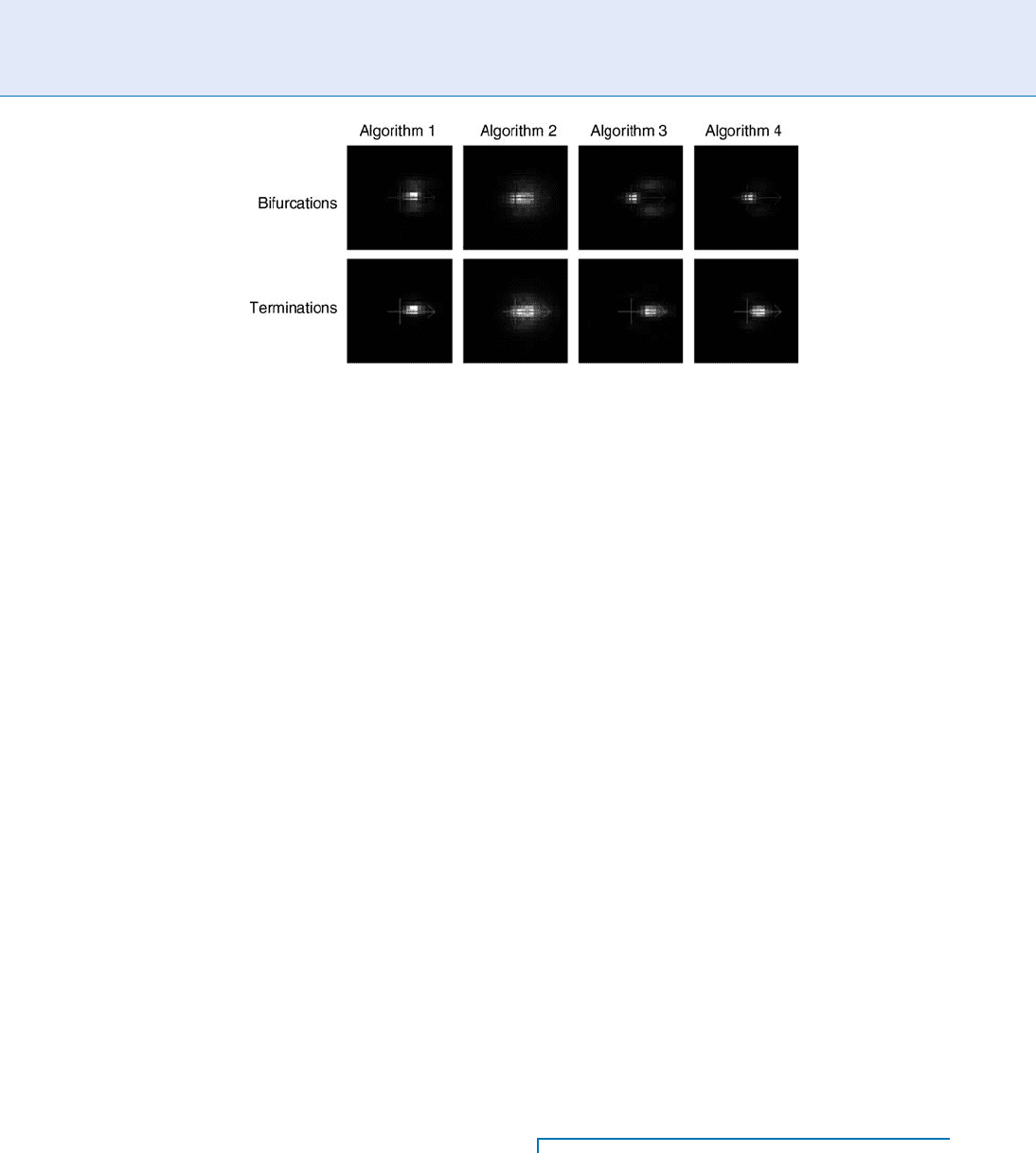
Related Entries
▶ Anatomy of Fingerprint
▶ Finger Data Interchange Format, Standardization
▶ Fingerprint Classification
▶ Fingerprint Databases and Evaluation
▶ Fingerprint Features
▶ Fingerprint Indexing
▶ Fingerprint Noise
▶ Fingerprint Orientation Field
▶ Fingerprint Ridge-line Pattern
▶ Fingerprint Sample Synthesis
▶ Fingerprint Singularities, Minutiae, Pores
▶ Performance Measures
▶ Privacy Issues
▶ Support Vector Machine
References
1. Biometric System Laboratory (University of Bologna) web site,
Available at: http://biolab.csr.unibo.it. Accessed January 2008
2. Cappelli, R., Erol, A., Maio, D., Maltoni, D: ‘‘Synthetic
Fingerprint-image Generation.’’ In: Proceedings of the 15th In-
ternational Conference on Pattern Recognition, Barcelona,
vol. 3, pp. 475–478 September (2000)
3. Maio, D., Maltoni, D., Cappelli, R., Wayman, J.L., Jain, A.K.:
FVC2000: Fingerprint Verification Competition. IEEE Trans
Pattern Anal Mach Intell 24(3), 402–412 (2002)
4. Cappelli, R., Maio, D., Maltoni, D: ‘‘Synthetic Fingerprint-
Database Generation.’’ In: Proceedings of the 16th International
Conference on Pattern Recognition, Que
´
bec City, vol. 3,
pp. 744–747, August (2002)
5. Cappelli, R: Synthetic fingerprint generation, In: Maltoni, D.,
Maio, D., Jain, A.K., Prabhakar, S. (eds.) Handbook of Finger-
print Recognition, Springer, New York, (2003)
6. Cappelli, R., Maio, D., Maltoni, D., ‘‘An Improved Noise Model for
the Generation of Synthetic Fingerprints.’’ In: Proceedings Eighth
International Conference on Control, Automation, Robotics and
Vision (ICARCV2004), Kunming, China, December (2004)
7. Cappelli, R: ‘‘Use of Synthetic Data for Evaluating the Quality of
Minutia Extraction Algorithms’’, In: Proceedings of the Second
NIST Biometric Quality Workshop, Gaithersburg, Maryland,
November (2007)
8. Saito, M., Matsumoto, M: ‘‘SIMD-oriented Fast Mersenne
Twister: a 128-bit Pseudorandom Number Generator’’, Monte
Carlo and Quasi-Monte Carlo Methods 2006, pp. 607–622.
Springer, New York, (2008)
9. ISO/IEC 19794-2:2005, Information technology – Biometric
data interchange formats – Part 2: Finger minutiae data
10. Cappelli, R., Maio, D., Maltoni, D., Wayman, J.L., Jain, A.K.
Performance Evaluation of Fingerprint Verification Systems.
IEEE Trans Pattern Anal Mach Intell. 28(1), 3–18 (2006)
11. Cappelli, R., Maio, D., Maltoni, D: ‘‘Indexing Fingerprint
Databases for Efficient 1:N Matching.’’ In: Proceedings of the
Sixth International Conference on Control, Automation, Robot-
ics and Vision (ICARCV2000), Singapore, December (2000)
12. Minutiae Interoperability Exchange Test (MINEX) web site,
Available at: http://fingerprint.nist.gov/minex04. Accessed
January 2008
13. Minutiae Template Interoperability Testing (MTIT) Project
web site, Available at: http://www.mtitproject.com. Accessed
January 2008
Shape
‘‘Shape is all the geometric information that remains
when location, scale and rotational effects are filtered
out from the object’’. Kendall’s statistical shape is
a sparse descriptor of the shape that describes
SFinGe. Figure 11 Distributions of minutiae placement and direction as estimated in [7] for some feature extraction
algorithms. In each image, the intensity I[x, y] is proportional to the estimated likelihood that a minutia will be found by an
algorithm at position (x, y) with respect to the ground-truth minutia direction (denoted by the arrow).
1176
S
Shape

the shape configuration of k landmark points in an m-
dimensional space as a k m matrix containing the
coordinates of the landmarks from which scale and
translation are filtered out. This shape feature therefore
lies on a spherical manifold which is well studied and
therefore properly defined distance measures are avail-
able in this manifold to perform recognition.
▶ Gait Biometrics, Overview
▶ Gait Recognition, Model-Based
Shape Index
Shape index Si, a quantitative measure of the shape of a
surface at a point p, is defined by (1),
S
i
ðpÞ¼
1
2
1
p
tan
1
k
1
ðpÞþk
2
ðpÞ
k
1
ðpÞk
2
ðpÞ
ð1Þ
where k1 and k2 are maximum and minimum princi-
pal curvatures, respectively. With this definition, all
shapes can be mapped into the interval S
i
2[0,1]. The
larger shape index values represent convex surfaces and
smaller shape index values represent concave surfaces.
▶ Ear Biometrics, 3D
Shape Model
Shape model is often embedded within a structural
model. It uses geometrical shapes e.g., stick figures as
a reduced representation of human body, blob, or
cylinder to represent body masses, or silhouette outline
of a human figure obtained from edge information to
describe the body of interest.
▶ Gait Recognition, Model-Based
Shape vs. Texture
▶ Face Recognition, Geometric vs. Appearance-Based
Shielding Functions
A theoretical approach to cancelable biometrics devel-
oped by Linnartz et al. (2003). Shielding functions allow a
verifier to check the authenticity of a prov er (user want-
ing to be verified) without learning any biometric infor-
mation. The scheme depends on proposed d-contracting
and e-revealing functions, which allow testing whether
measured features are within a range. Under some
assumptions, a biometric may be tested without learning
anything about the biometric feature values. One limita-
tion of this scheme is that biometric samples are assumed
to be perfectly registered. This scheme offers an interest-
ing cryptographic basis for the construction of encrypted
biometric systems, and it is used by several authors.
▶ Cancelable Biometrics
Shoeprint Matching
▶ Footwear Recognition
Shot Noise
For image sensors, photon conversion into electrons at
a pixel is a random event. Random fluctuations in the
number of electrons for a fixed numbe r of photons are
referred to as shot noise. The standard model for shot
noise is that the noise is proportional to the square
root of the number of electrons generated. Hence, the
signal/noise ratio is proportional to √ N, where N is the
number of electrons.
▶ Biometric Sensor and Device, Overview
▶ Iris Device
Side-Channel Attacks
Side-channel attack is an attack against a cryptographic
or biometric security system based on measurements
Side-Channel Attacks
S
1177
S

of the implementation of the system, rather than
on weaknesses in the algorithms. For example, side-
channel attacks may use timing, power consumption,
or electromagnetic measurements on the security
device. Side-channel attacks are primarily of concern
for biometric encryption systems and match-on-card
devices where an attack could potentially be mounted
by iteratively improving the presented biometric. Very
little research has been done to explore the feasibil-
ity of side-channel attacks, but the success of attacks
on biome tric template security and biometric encryp-
tion suggests that such attacks are certainly feasible.
▶ Security and Liveness, Overview
Signal to Noise Ratio
Information is transmitted or recorded by variations in a
physical quantity. For any information storage or trans-
mission system, there will be intended variations in the
physical quantity – signal – and unintended variations –
noise. In an analog telephone system, the signal (voice) is
represented by variation in a voltage level. As the signal is
transmitted along a phone line, it can pickup other
unintended variations – e.g., leakage of other signals,
static from electrical storms – that are noise. The ratio
of the signal level to the noise level is the signal to noise
ratio (SNR). Since it is a ratio, SNR is dimensionless.
However, SNR can be expressed as either an amplitude
ratio (voltage ratio for the phone example) or a power
ratio (milliWatts for the phone example). This leads to
confusion. SNR is frequently expressed as the log (base
10) of the ratio. When expressed as a log, the dimension-
less unit of SNR is decibel (dB).
What is signal and what is noise can depend on the
circumstances. Radio waves from lighting are noise to
an AM radio broadcast, but can be signal to a meteo-
rological experiment.
▶ Iris Device
Signature Benchmark
▶ Signature Databases and Evaluation
Signature Characteristics
▶ Signature Features
Signature Corporate
▶ Signature Databases and Evaluation
Signature Databases and Evaluation
MARCOS MARTINEZ-DIAZ,JULIAN FIERREZ
Biometric Recognition Group - ATVS,
Escuela Politecnica Superior, Universidad
Autonoma de Madrid, Campus de Canto blanco,
Madrid, Spain
Synonyms
Signature benchmark; Signature corpora; Signature
data set
Definition
Signature datab ases are structured sets of collected
signatures from a group of individuals that are used
either for evaluation of recognition algorithms or as
part of an operational system.
Signature databases for evaluation purposes are, in
general, collections of signatures acquired using a
digitizing device such as a pen tablet or a touch-
screen. Publi cly available databases all ow a fair
performance comparison of signature recognition
algorithms propose d by independent entities. More-
over, signature databases play a central role in public
performance evaluations, which compare different
recognition algo rithms by using a common experi-
me ntal frame work. This type of databases is covered
in this entr y.
On the other hand, signature databases can also be
a module of a verification or identification system.
1178
S
Signal to Noise Ratio

They store signature data and other personal informa-
tion of the enrolled users. This signature database is
used during the operation of the recognition system
to retrieve the enrolled data needed to perform the
biometric matching. This kind of databases is not
addressed here.
Dynamic Signature Databases
Until the beginning of this century, research on auto-
matic signature verification had been carried out using
privately collected databases, since no public ones were
available. This fact limits the possibilities to compare
the performance of different systems presented in the
literature, which may have been tuned to specific cap-
ture conditions. Additionally, the usag e of small data
sets reduces the statistical relevance of experiments.
The lack of publicly available databases has also been
motivated by privacy and legal issues , although the
data in these databases are detached from any personal
information. The impact of the signature structural
differences among cultures must also be taken into
account when considering experimental results on a
specific database. As an example, in Europe, signatures
are usually formed by a fast writing followed by a
flourish, while in North America, they usually corre-
spond to the signers name with no flourish. On the
other hand, signatures in Asia are commonly formed
by Asian characters, which are composed of a larger
number of short strokes compared with European or
North American signatures.
While some authors have made public the data-
bases used for their experimental results [1], most
current dynamic signature databases are collected by
the joint effort of different research institutions. These
databases are, in general, freely available or can be
obtained at a reduced cost. Many signature databases
are part of larger multimodal biometric databases,
which include other traits such as fingerprint or face
data. This is done for two main reasons: the research
interest on multimodal algorithms and the low effort
required to incorporate the collection of other biomet-
ric traits once a database acquisition campaign has
been organized.
Two main modalities in signature recognition exist.
Off-line systems use signature images that have been
previously captured with a scanner or camera. On the
other hand, on-line systems employ digitized signals
from the signature dynamics such as the pen position
or pressure. These signals must be captu red with spe-
cific devices such as
▶ pen tablets or ▶ touch-screens.
The most popular databases in the biometric research
community are oriented to on-line verification,
although in some of them, the scanned signature
images are also available [2, 3]. Some efforts have been
carried out in the handwriting community to collect
large off-line signature databases such as the GPDS-960
Corpus [4].
Unlike other biometric traits, signatures can be
forged with relative ease. Signature verification systems
must not only discriminate traits from different sub-
jects (such as fingerprints) but also must discriminate
between genuine signatures and forgeries. In general,
signature databases provide a number of forgeries for
the signatures of each user. The accuracy of the for-
geries depends on the acquisition protocol, the skill of
the forgers, and on how much time the forgers are let
to train. Nevertheless, forgeries in signature databases
are usually performed by subjects with no prior expe-
rience in forging signatures, this being a limitation to
the quality of fo rgeries.
Most on-line signature databases have been cap-
tured with
▶ digitizing tablets. These tablets are, in
general, based on an electromagnetic principle, allow-
ing the detection of the pen position (x,y), inclination
angles (y,g)¼(azimuth, altitude), and pressure p. They
allow recording the pen dynamics even when the pen is
not in contact with the signing surface (i.e., during
pen-ups). On the other hand, datab ases captured
with other devices such as touch-screens (e.g., PDAs)
provide only pen position information, which is
recorded exclusively when the pen is in contact with
the device surface.
In the following, a brief description of the most
relevant available on-line signature databases is given
in chronological order.
PHILIPS Database
Signatures from 51 users were captured using a Philips
Advanced Interactive Display (PAID) digitizing tablet
at a sampli ng rate of 200 Hz [5]. The following signals
were captured: position coordinates, pressure, azi-
muth, and altitude.
Each user contributed 30 genuine signatures, leading
to 1,530 genuine signatures. Three types of forgeries are
present in the database: 1,470 over-the-shoulder for-
geries, 1,530 home-improved, and 240 professional
Signature Databases and Evaluation
S
1179
S
